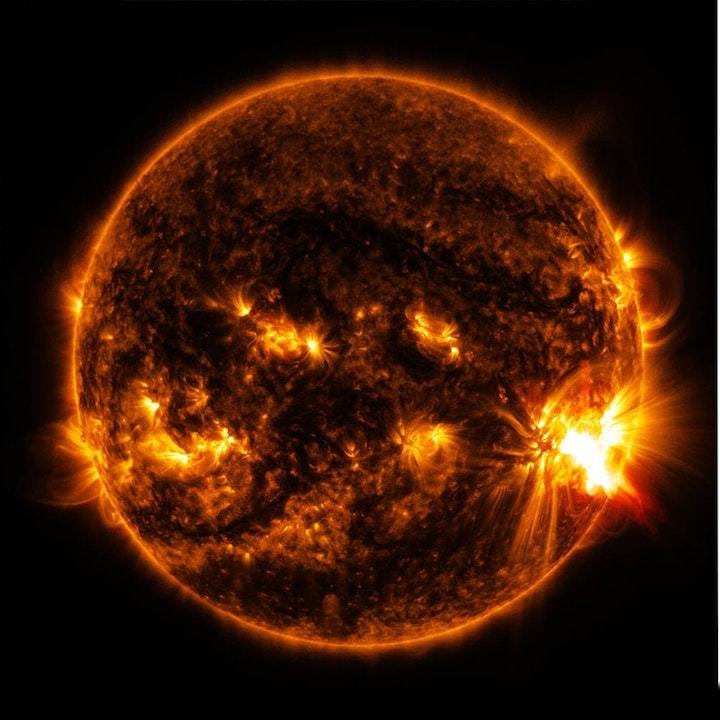13.04.2018
Huge solar storms that bombarded the early Earth with radiation could have kept the planet warm and built the molecules of life. Richard A. Lovett reports.

Gigantic solar storms may have helped strip unwanted gases from the Earth’s atmosphere, while helping to seed its surface with the chemicals for life, scientists say.
The storms may also have set in motion chemical reactions that helped keep the Earth and Mars warm enough for liquid water early in their histories, when the Sun was putting out 30 percent less energy than it is today.
In the modern world, such storms would be disasters that blacked out power grids and disrupted communications. But early in our Solar System’s history, storms an order of magnitude bigger than anything humanity has ever seen would have been common.
“The early Earth was continuously exposed [to them],” NASA physicist Chigomezyo Ngwira told a NASA-sponsored symposium called ‘Environments of Terrestrial Planets Under the Young Sun: Seeds of Biomolecules,’ this week in Greenbelt, Maryland.
Radiation from these solar superstorms would have pumped energy into the early Earth’s upper atmosphere, with some of the radiation penetrating deeply enough to create a cascade of chemical reactions extending all the way into the lower atmosphere, Ngwira says.
The storms would have deposited 100 times more energy into the upper atmosphere than modern ones, adds Vladimir Airapetian, an astrophysicist at NASA Goddard. This would have heated the upper atmosphere to hundreds of thousands of degrees and caused it to balloon outward, where gases like hydrogen could be easily lost to space.
That’s important, according to Manuel Güdel, an astrophysicist from the University of Vienna, Austria, because the early Earth might have swept up enough hydrogen and helium during its formation to have had a fairly substantial hydrogen/helium “envelope” that would have been “inimical” to habitability. If it had remained, he says, the Earth might have become a gaseous “mini-Neptune,” rather than the planet we know today.
Lower down, radiation from solar superstorms could have set off cascades of collisions that would have smashed molecules and left a wake of ionized particles extending deep into the atmosphere, says NASA researcher Guillaume Gronoff. Of particular importance, he says, is that these particles would have carried enough energy to break up molecules of nitrogen gas, carbon dioxide, water, and methane. This would have created a highly reactive chemical stew from which a number of other molecules could form, including hydrogen cyanide (HCN).
Hydrogen cyanide is a deadly poison, but it and other chemicals created by the same process would have become building blocks for more complex compounds, such as amino acids, sugars, nucleotides, and other basic components of life.
“So we are creating a lot of molecules that are going down into the ocean, both at Mars and the Earth,” Gronoff says. Nor were they produced only in small quantities. For hydrogen cyanide alone, Gronoff calculates that the rate of deposition onto the surface could have been on the order of 2 billion tonnes per year.
At the same time, another product of that solar bombardment, nitrous oxide (N2O)— once known to dental patients as laughing gas — could have helped keep those oceans from freezing solid.
One of the puzzles about the early Earth is a riddle known as the “faint young Sun” paradox. Astrophysicists know that the Sun at that time was 30 percent dimmer than today. That’s dim enough that the Earth should have been too cold for liquid water. But geophysicists know that liquid water was present early in our history.
The same problem applies even more strongly to Mars, which also appears to have had an ocean early in its history, despite being even further from the Sun. How could that be?
The answer is that some greenhouse gas in the two planets’ atmospheres must have been trapping heat. The obvious answer is carbon dioxide but, Gronoff says, it’s hard to understand how that could have been present in sufficient quantities.
Nitrous oxide, however, is an even more powerful greenhouse gas – 300 times more potent than carbon dioxide – and it could fit the bill, Gronoff believes. “It’s enough to explain the faint young sun paradox,” he says.
All of this is also relevant to the search for habitable planets circling other stars because it means we may need to redefine our understanding of the “habitable zone” around them.
This region of space is where a planet’s surface could be warm enough to support liquid water, without being so hot that it would all evaporate.
Many of the exoplanet systems currently being studied, however, are around stars that generate considerable numbers of flares. That means that conditions on their planets might be more like those on the early Earth than in our present Solar System, including the creation of planet-warming nitrous oxide in their atmospheres.
If so, Gronoff says, these stars may have habitable zones extending farther outward than previously thought. “We may be moving the habitable zone a bit further [out],” he says.
Quelle: COSMOS
